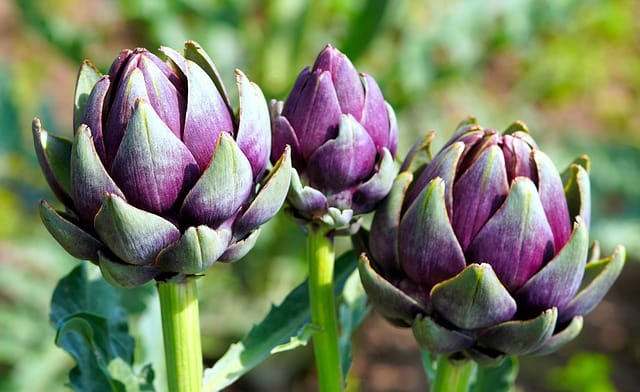How to grow Globe Artichokes
Globe artichokes are delicious and nutritious vegetables that can be easily grown in your garden

In this article:
- Introduction
- Understanding Globe Artichokes
- Choosing the Right Location
- Preparing the Soil
- Starting from Seeds or Transplants
- Planting Globe Artichokes
- Watering and Fertilizing
- Managing Pests and Diseases
- Pruning and Harvesting
- Overwintering the Plants
- Common Issues and Troubleshooting
- Culinary Uses and Recipes
- Conclusion
Introduction
Globe artichokes are delicious and nutritious vegetables that can be easily grown in your garden. They are not only aesthetically pleasing with their large, thistle-like flower buds but also provide a bountiful harvest when properly cared for. In this article, we will guide you through all the necessary steps to grow and maintain your own globe artichokes.
Understanding Globe Artichokes
Globe artichokes (Cynara cardunculus var. scolymus) are perennial vegetables that belong to the thistle family. They are native to the Mediterranean region and have been cultivated for culinary purposes for centuries. The edible part of the plant is the immature flower bud, which is harvested before it blooms. Globe artichokes are known for their unique flavor and numerous health benefits.
Choosing the Right Location
Globe artichokes prefer full sun and well-drained soil. Select a location in your garden that receives at least 6 hours of direct sunlight per day. The soil should be rich in organic matter and have a pH level between 6.0 and 7.5. Avoid areas with heavy clay or compacted soil, as it can hinder root development.
Preparing the Soil
Prior to planting, it's essential to prepare the soil properly. Start by removing any weeds or grass from the planting area. Loosen the soil with a garden fork or tiller to a depth of 12-18 inches. Incorporate organic matter such as compost or well-rotted manure to improve fertility and drainage. This will provide a nutrient-rich environment for the artichoke plants.
Starting from Seeds or Transplants
Globe artichokes can be started from seeds or transplants. If starting from seeds, sow them indoors 8-10 weeks before the last frost date. Transplants can be purchased from nurseries or garden centers. Choose sturdy and healthy seedlings that are around 6-8 inches tall. Harden off the transplants before planting them in the garden to acclimate them to outdoor conditions.
Planting Globe Artichokes
Plant the globe artichoke transplants or seedlings in the garden after the threat of frost has passed. Space them 3-4 feet apart to allow enough room for the plants to grow and spread. Dig a hole slightly larger than the root ball and gently place the plant in it. Ensure that the crown is level with the soil surface. Backfill the hole and firm the soil gently around the plant.
Watering and Fertilizing
Globe artichokes require regular watering to establish and grow. Keep the soil consistently moist but not waterlogged. Water deeply once or twice a week, aiming for a total of 1-2 inches of water per week. Apply a balanced organic fertilizer in early spring and again after the first harvest to provide the plants with essential nutrients.
Managing Pests and Diseases
Globe artichokes are relatively resistant to pests and diseases. However, caterpillars, slugs, and aphids can occasionally attack the foliage. Regularly inspect the plants and manually remove any pests you come across. You can also use organic pest control methods such as neem oil or insecticidal soaps. Proper sanitation and good airflow around the plants can help prevent diseases such as powdery mildew.
Pruning and Harvesting
Pruning is an important aspect of globe artichoke care. Remove any dead or damaged leaves throughout the growing season to maintain plant health. After harvesting the main flower bud, cut it with a sharp knife about 1-2 inches below the bud. This will encourage the growth of additional smaller buds or side shoots, known as secondary heads, which can be harvested later.
Overwintering the Plants
In regions with cold winters, globe artichokes need protection from frost. Before the first frost, cut back the plant to about 6-8 inches above the soil surface. Apply a thick layer of mulch around the base of the plant to insulate the crown. In spring, remove the mulch and allow new growth to emerge. The plant may not produce as vigorously in subsequent years, so dividing and replanting every few years may be necessary.
Common Issues and Troubleshooting
Globe artichokes are generally low-maintenance, but they can face a few issues. Yellowing leaves may indicate nitrogen deficiency, while small or misshapen buds could be due to irregular watering. Pests, such as aphids or caterpillars, can be treated with organic methods mentioned earlier. If you encounter other problems, consult your local extension office or a gardening expert for specific advice.
Culinary Uses and Recipes
Globe artichokes are incredibly versatile in the kitchen. The tender meat of the artichoke bud can be steamed, boiled, grilled, or stuffed. The bottom part of the leaves can be scraped with your teeth to enjoy the flesh. Artichoke hearts are a delicacy, often used in salads, dips, and pasta dishes. Get creative and explore various recipes that highlight the unique flavor of globe artichokes.
Conclusion
By following these guidelines, you can successfully grow and enjoy your own globe artichokes. With a little patience and care, you will be rewarded with a bountiful harvest of delicious and nutritious vegetables. Cultivating globe artichokes will not only enhance your garden but also provide you with culinary delights for years to come.
